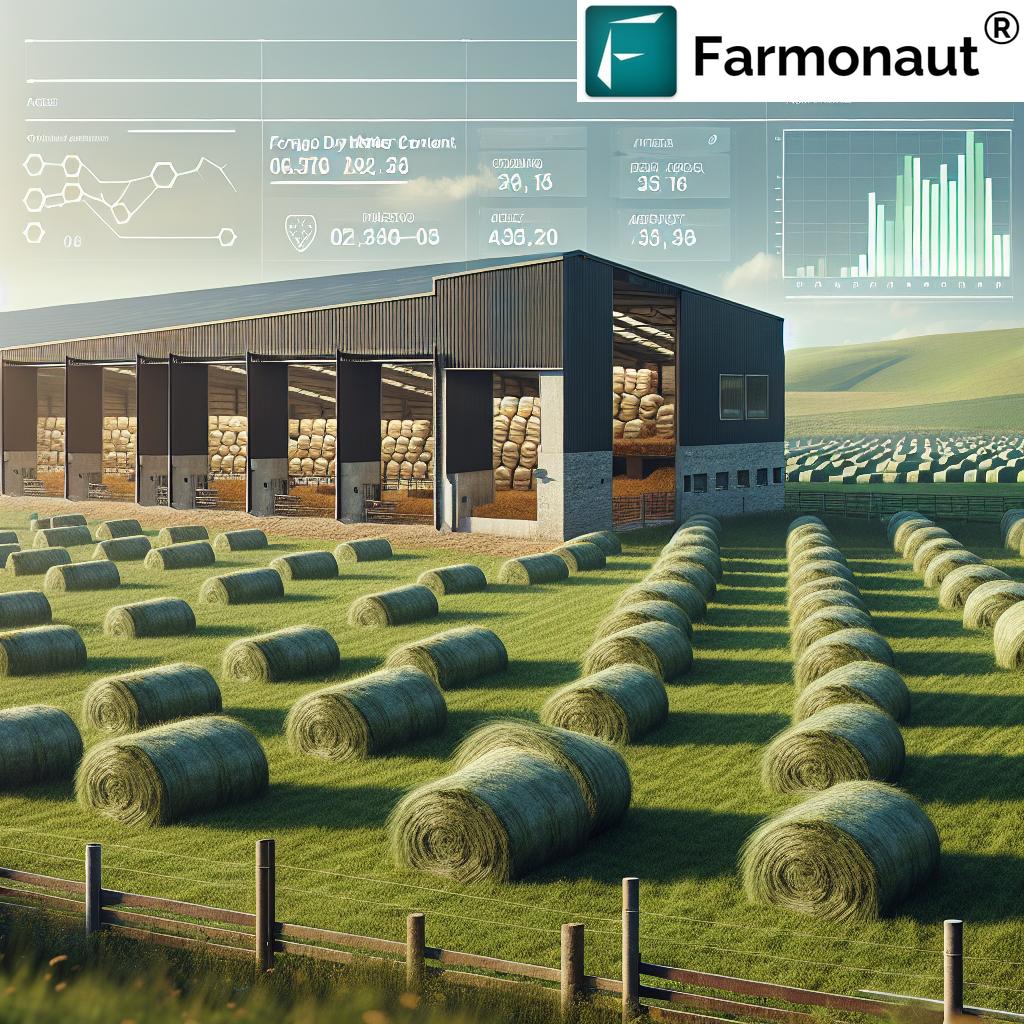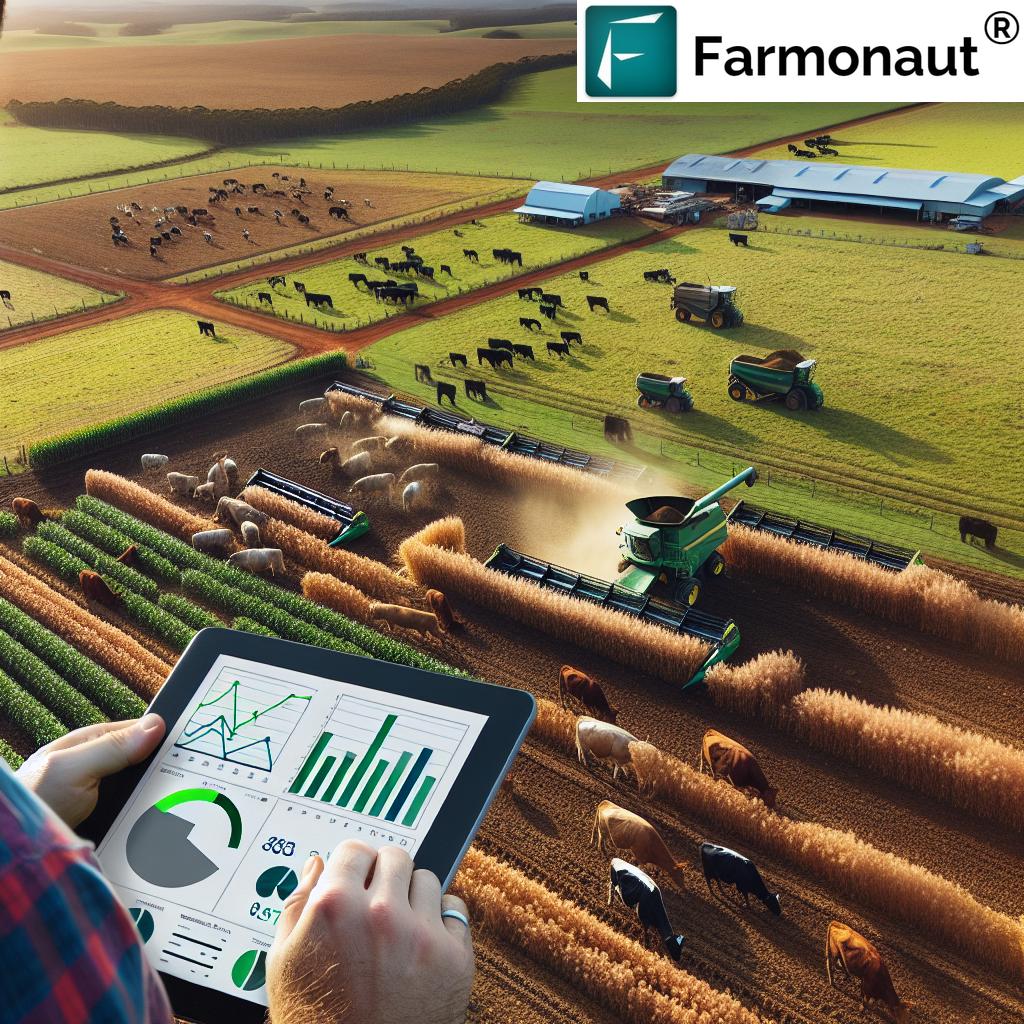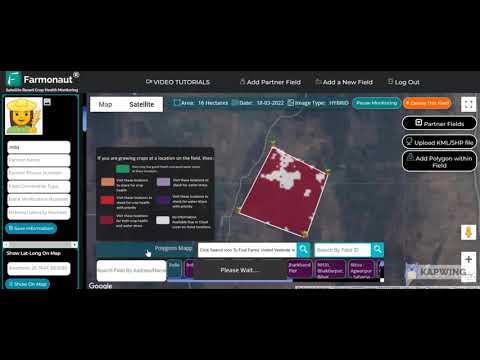Maximizing Silage Quality: 10 Essential Steps for NSW Farmers to Optimize Livestock Feed and Boost Productivity
“Proper silage management can increase livestock feed quality by up to 30% and boost farm productivity significantly.”
Welcome to our comprehensive guide on maximizing silage quality for New South Wales (NSW) farmers. In this blog post, we’ll explore ten essential steps to optimize livestock feed and boost productivity through effective silage production techniques and hay quality management. As agricultural data analysis and crop management software become increasingly important in modern farming, we’ll also discuss how precision farming technology can enhance your forage and livestock feed optimization efforts.

At Farmonaut, we understand the challenges faced by NSW farmers in producing high-quality silage and managing hay quality. Our satellite-based farm management solutions offer valuable insights into pasture productivity, crop health, and resource management. By leveraging our advanced technologies, farmers can make data-driven decisions to improve their silage production and overall farm performance.
The Importance of Quality Silage for NSW Livestock Producers
Quality silage plays a crucial role in livestock nutrition and farm productivity. For NSW farmers, producing high-quality silage is essential for:
- Ensuring consistent feed supply throughout the year
- Maximizing livestock growth and production
- Reducing feed costs and improving farm profitability
- Enhancing animal health and welfare
- Mitigating the effects of drought and climate variability
To help you achieve these benefits, we’ve compiled a list of ten essential steps for optimizing silage quality. Let’s dive in!
10 Essential Steps for Optimizing Silage Quality
| Step | Description/Best Practices |
|---|---|
| 1. Selecting Ideal Pastures | Choose high-quality forages with optimal nutrient content and yield potential. |
| 2. Timing the Harvest | Cut at the right stage of maturity to balance yield and nutritional value. |
| 3. Mastering the Wilting Process | Achieve optimal dry matter content (30-35%) through proper wilting techniques. |
| 4. Chopping Length | Ensure correct chop length (10-20mm) for proper fermentation and compaction. |
| 5. Rapid Filling and Sealing | Fill and seal the silo quickly to minimize oxygen exposure and spoilage. |
| 6. Proper Compaction | Compact thoroughly to remove air pockets and promote anaerobic fermentation. |
| 7. Using Silage Additives | Apply appropriate additives to enhance fermentation and preservation. |
| 8. Maintaining Airtight Storage | Ensure silos or bales are properly sealed to prevent air infiltration. |
| 9. Monitoring Fermentation | Regularly check pH levels and temperature during the fermentation process. |
| 10. Assessing Feed Quality | Conduct laboratory analysis to evaluate nutritional content and adjust rations. |
Now, let’s explore each of these steps in detail to help you maximize your silage quality and optimize livestock feed.
1. Selecting Ideal Pastures
The foundation of high-quality silage begins with selecting the right pastures. In NSW, common forage crops for silage production include:
- Maize (corn)
- Sorghum
- Lucerne (alfalfa)
- Ryegrass
- Oats
When choosing pastures for silage, consider the following factors:
- Yield potential: Select varieties known for high dry matter yield in your region.
- Nutritional value: Look for forages with high energy and protein content.
- Drought resistance: In NSW’s variable climate, choose drought-resistant forage crops to ensure consistent production.
- Soil type and fertility: Match pasture species to your soil conditions for optimal growth.
- Disease and pest resistance: Select varieties with strong resistance to common local pests and diseases.
Farmonaut’s satellite-based crop health monitoring can help you assess pasture health and productivity, enabling data-driven decisions in pasture selection and management.
2. Timing the Harvest
Proper timing of the harvest is crucial for achieving the right balance between yield and nutritional value. The optimal harvest time varies depending on the forage crop:
- Maize: Harvest at 30-35% dry matter content, typically when the milk line is 1/2 to 2/3 down the kernel.
- Sorghum: Cut at the soft dough stage, with a dry matter content of 30-35%.
- Lucerne: Harvest at early bloom stage for dairy cattle, or mid-bloom for beef cattle.
- Ryegrass: Cut when the crop reaches the boot to early heading stage.
- Oats: Harvest at the milk to soft dough stage for optimal quality.
Using Farmonaut’s precision farming technology, you can monitor crop development and receive alerts for optimal harvest timing based on satellite imagery and weather data.
3. Mastering the Wilting Process
Proper wilting is essential for achieving the ideal dry matter content in your silage. The target dry matter content for most silage crops is between 30-35%. Here are some tips for mastering the wilting process:
- Mow crops in wide swaths to maximize sun exposure and speed up drying.
- Use a mower conditioner to crack stems and promote faster, more even drying.
- Monitor weather forecasts and plan harvesting around optimal drying conditions.
- Aim for a wilting period of 24-48 hours, depending on crop type and weather conditions.
- Use a moisture tester to accurately determine dry matter content before chopping.
Farmonaut’s weather forecasting tools can help you plan your wilting process more effectively, ensuring optimal drying conditions for your silage crops.
4. Chopping Length
Achieving the correct chop length is crucial for proper fermentation, compaction, and animal digestibility. The ideal chop length varies depending on the crop and livestock type:
- Maize silage: 10-20mm for dairy cows, slightly longer for beef cattle
- Grass and legume silage: 20-40mm, depending on dry matter content
- Sorghum silage: 10-15mm to ensure proper kernel processing
Regularly check and maintain your forage harvester to ensure consistent chop length throughout the harvest. Proper chopping promotes better compaction, reduces air pockets, and improves fermentation quality.
5. Rapid Filling and Sealing
Quick filling and sealing of the silo or bale is essential to minimize oxygen exposure and prevent spoilage. Follow these best practices:
- Fill the silo or create bales as quickly as possible, ideally within 24-48 hours.
- Use proper equipment and adequate labor to ensure efficient filling and compaction.
- Seal the silo or wrap bales immediately after filling to prevent air infiltration.
- For bunker silos, use high-quality plastic sheets and ensure proper overlap.
- For baled silage, apply multiple layers of wrap (at least 4-6) to ensure an airtight seal.
Efficient filling and sealing help create the anaerobic environment necessary for proper fermentation and preservation of your silage.

6. Proper Compaction
Thorough compaction is crucial for removing air pockets and promoting anaerobic fermentation. Here are some tips for achieving proper compaction:
- Use heavy tractors or dedicated compaction equipment to apply continuous pressure.
- Spread silage in thin layers (15-20cm) and compact each layer thoroughly.
- Aim for a packing density of at least 225 kg of dry matter per cubic meter.
- Continue compacting for 1-2 hours after filling is complete to ensure maximum density.
- For baled silage, ensure proper bale density through correct baler settings.
Proper compaction reduces the risk of spoilage, improves fermentation quality, and maximizes storage capacity.
7. Using Silage Additives
Silage additives can enhance fermentation, improve preservation, and increase nutritional value. Common types of additives include:
- Bacterial inoculants: Promote rapid pH drop and improve fermentation.
- Enzymes: Break down complex carbohydrates to improve digestibility.
- Organic acids: Inhibit undesirable bacteria and molds.
- Nutrients: Enhance the nutritional profile of the silage.
When choosing additives, consider factors such as crop type, dry matter content, and storage conditions. Always follow manufacturer recommendations for application rates and methods.
8. Maintaining Airtight Storage
Maintaining an airtight environment is crucial for preserving silage quality. Follow these best practices:
- Regularly inspect silo walls, doors, and plastic covers for damage or leaks.
- Repair any holes or tears in plastic covers immediately.
- Use sand or gravel bags to weigh down plastic covers and ensure a tight seal.
- For baled silage, store bales in a well-drained area and protect them from wildlife damage.
- Monitor silage temperature and watch for signs of heating, which may indicate air infiltration.
Proper storage management helps maintain silage quality throughout the feeding period and minimizes waste.
9. Monitoring Fermentation
Regularly monitoring the fermentation process is essential for ensuring silage quality. Key parameters to monitor include:
- pH: Should drop to 3.8-4.2 within 3-4 weeks for corn silage, 4.0-4.5 for grass silage.
- Temperature: Should not exceed 38°C (100°F) during fermentation.
- Dry matter content: Should remain stable throughout storage.
- Odor: A pleasant, slightly acidic smell indicates good fermentation.
Using Farmonaut’s agricultural data analysis tools, you can track and record these parameters to identify any issues early and take corrective action if needed.
10. Assessing Feed Quality
Regular assessment of silage quality is crucial for optimizing livestock nutrition and performance. Consider the following practices:
- Conduct laboratory analysis of silage samples to determine nutritional content.
- Test for parameters such as dry matter, crude protein, fiber content, and energy value.
- Use near-infrared spectroscopy (NIRS) for rapid on-farm analysis of silage quality.
- Adjust livestock rations based on silage quality to meet nutritional requirements.
- Monitor animal performance and adjust feeding strategies as needed.
Farmonaut’s platform can help you track and analyze feed quality data, enabling data-driven decisions in livestock nutrition management.
“Laboratory testing of animal feeds can analyze over 50 different nutritional parameters to optimize livestock diets.”
Leveraging Technology for Silage Production and Management
Modern technology plays a crucial role in optimizing silage production and management. Here’s how Farmonaut’s solutions can help NSW farmers improve their silage quality and overall farm performance:
- Satellite-based crop health monitoring: Track pasture growth and health to optimize harvest timing and yield.
- Weather forecasting: Plan harvesting and wilting processes based on accurate local weather predictions.
- Soil moisture monitoring: Manage irrigation and optimize crop water use for improved forage quality.
- Farm management tools: Track silage production, storage, and feeding to improve overall efficiency.
- Data analysis and reporting: Generate insights from historical data to inform future management decisions.
By integrating these technologies into your silage production process, you can make more informed decisions and achieve better results.
Access Farmonaut’s powerful farm management tools:
Managing Silage Quality During Drought Conditions
NSW farmers often face challenges related to drought and climate variability. Here are some strategies for maintaining silage quality during dry periods:
- Consider drought-resistant forage crops such as sorghum or millet.
- Implement water-efficient irrigation systems to maximize crop growth.
- Adjust cutting height to balance yield and regrowth potential.
- Use silage additives to improve fermentation in drought-stressed crops.
- Monitor moisture content closely, as drought-stressed crops may have higher dry matter content.
Farmonaut’s satellite-based monitoring can help you track soil moisture levels and crop stress, enabling proactive management during drought conditions.
Optimizing Hay Quality Management
In addition to silage, high-quality hay is an important component of livestock feed in NSW. Here are some tips for optimizing hay quality:
- Time the harvest based on crop maturity and weather conditions.
- Use a mower conditioner to speed up drying and reduce leaf loss.
- Rake or ted hay at the appropriate moisture content to minimize leaf shatter.
- Bale at the correct moisture content (14-18% for small square bales, 12-16% for large round bales).
- Store hay in a dry, well-ventilated area to prevent spoilage and maintain quality.
Farmonaut’s weather forecasting tools can help you plan hay harvesting and drying operations more effectively, ensuring optimal quality.
The Impact of Heating on Hay Nutritional Value
Excessive heating during storage can significantly impact hay quality and nutritional value. Here’s what you need to know:
- Heating above 40°C (104°F) can lead to Maillard reactions, reducing protein digestibility.
- Temperatures above 50°C (122°F) can result in significant dry matter and energy losses.
- Extreme heating (>70°C or 158°F) can lead to spontaneous combustion and fire risk.
To prevent heating and maintain hay quality:
- Bale at the correct moisture content.
- Use preservatives for hay baled at higher moisture levels.
- Store hay in a well-ventilated area with proper spacing between bales.
- Monitor hay temperature regularly during the first few weeks of storage.
Measuring Forage Dry Matter Content
Accurate measurement of forage dry matter content is crucial for proper silage and hay management. Here are some methods for measuring dry matter content:
- Microwave method: Quick and easy, but requires careful attention to prevent overheating.
- Koster tester: Provides accurate results in about 30 minutes.
- Near-infrared spectroscopy (NIRS): Rapid and non-destructive, but requires calibration.
- Laboratory oven drying: Most accurate method, but requires specialized equipment and time.
Regardless of the method used, consistent and accurate dry matter measurement is essential for optimizing silage and hay quality.
Farmonaut’s Role in Optimizing Silage and Hay Production
Farmonaut’s advanced satellite-based farm management solutions offer valuable tools for NSW farmers looking to optimize their silage and hay production. Our platform provides:
- Real-time crop health monitoring to inform harvest timing decisions.
- Soil moisture tracking to optimize irrigation and crop management.
- Weather forecasting to plan harvesting and wilting operations.
- Data analysis tools to track and improve farm performance over time.
- Integration with other farm management systems for comprehensive decision support.
By leveraging these technologies, NSW farmers can make data-driven decisions to improve silage and hay quality, optimize livestock feed, and boost overall farm productivity.
Explore Farmonaut’s API for custom integrations:
Conclusion
Maximizing silage quality and optimizing livestock feed is crucial for NSW farmers looking to boost productivity and profitability. By following the ten essential steps outlined in this guide and leveraging advanced technologies like Farmonaut’s satellite-based farm management solutions, you can achieve significant improvements in your silage and hay production processes.
Remember that producing high-quality silage and hay is an ongoing process that requires attention to detail, consistent monitoring, and a willingness to adapt to changing conditions. By staying informed about the latest agricultural data analysis techniques and implementing precision farming technology, you can stay ahead of the curve and ensure the best possible outcomes for your livestock and your farm.
FAQ Section
Q: How often should I test my silage quality?
A: It’s recommended to test silage quality at least once every 2-3 weeks during the feeding period, or more frequently if you notice any changes in animal performance or silage characteristics.
Q: Can I use Farmonaut’s technology for small-scale farms?
A: Yes, Farmonaut’s solutions are scalable and can be used by farms of all sizes, from small family operations to large commercial enterprises.
Q: How can I prevent mold growth in my silage?
A: To prevent mold growth, ensure proper harvesting at the right moisture content, achieve good compaction, maintain an airtight seal during storage, and manage the feed-out face to minimize air exposure.
Q: What are the signs of poor silage fermentation?
A: Signs of poor fermentation include a strong, unpleasant odor (e.g., rancid or butyric acid smell), excessive heating, visible mold growth, and a slimy texture.
Q: How can Farmonaut help me improve my pasture management for better silage production?
A: Farmonaut’s satellite-based crop health monitoring can help you track pasture growth, identify areas of stress or low productivity, and make informed decisions about fertilization, irrigation, and harvest timing to optimize silage production.






